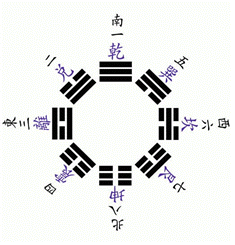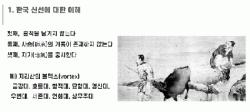학술대회논문
한국사상의 원형과 특질(Archetype and Characteristics of Korean Philosophical Thought)
최영성(한국전통문화대학교 교수)
2021년 봄 증산도 문화사상 국제학술대회논문
Archetype and Characteristics of Korean Philosophical Thought - In relation to Pung-ryu and National Religions -
Choi Young-seong (Professor, Department of Intangible Heritage, University of Korean Traditional Culture)
tr. by Dr. Cheon Won-cheol (Research Fellow of SCRI)
Summary
This article was written as a part of the work to explore the archetype of Korean thought on the 'philosophical' level and to collect and categorize its characteristics.
Pungryu-do (風流道), a religious body in ancient Korean history, began to reveal its substance starting from Dangun (檀君, ‘The Forefather of Korean Nation’), and then, during the Silla Dynasty, its influence increased through an organization called Hwarang (花郞, the Flowery Noble Youth). As Buddhism and Confucianism flourished in this land, its authority waned, but since the late 19th century, it has been brought to light again by modern indigenous religions.
It is for this reason that in this article, the Korean indigenous thought as understood in modern national religions is recognized as important. Korea's modern national religions usually resorts to the Dangun ideology. In other words, they are rooted in the traditional ideology of the nation. Faith and idea on Dangun is the ‘hometown of Korean thought’. We can find some kind of rationality, sentimentality, and spirituality at the foundation of traditional Korean thought. The characteristics of Korean traditional thought stem from this.
I. preface
Regarding the prototype or identity of Korean thought, our senior scholars expressed it as ‘guksu (國粹, the National Essence)’. Finding this ‘guksu’ must be an important task for those who study Korean philosophy and thought.
Late Professor Ryu Seung-guk (柳承國: 1923-2011) is a modern scholar who has conducted continuous and in-depth research on this issue. He left many achievements in exploring the origins of the archetype of Korean thought and the formation of ancient thought. In particular, the study of ancient Korean thought based on oracle bone studies marked a milestone in terms of academic science and historical consciousness.
Currently, among scholars majoring in Korean philosophy, there are not a few persons studying the ideas of the Three Kingdoms period, i.e., Confucianism, Buddhism, Taoism, and folk beliefs in each of these fields. However, there are very few scholars majoring in the origins of Korean indigenous thought. The level of research has not excelled that of the studies on Dangun, as conducted by Choi Namseon (崔南善: 1890∼1957) during the 1930s. Above all, their studies are not supported with the literary materials.
Even in the 1930s, the argument that ‘research on the ancient culture of Joseon should go beyond the limits of documentary basis’ was made outspokenly. However, research from such an perspective is not easy these days, under the pressure of academia that values literary and empirical evidence. In addition, scholars do not dare engage themselves in it because it is difficult to study lot of fields such as legend, folklore, language, history, geography, archeology, philosophy, and religion. The lack of excellent scholars may be another reason.
During the period when Korean nation was governed by Japan, Korean scholars concentrated their research capabilities on the study of ancient history. It is difficult to deny that their scholastic works were imbued with patriotism. Yet, high-quality results were achieved under poor research conditions. There were many things noticeable, especially in terms of spiritual realm and philosophical thought.
In this article, I try to approach the archetype of Korean indigenous thought from a 'philosophical level'. Next, based on that, I will examine the characteristics of Korean thought. Methodologically, first of all, I will start from the famous saying, ‘Our Country has a profound Tao called Pungryu (國有玄妙之道曰風流)’, as testified by Choi Chiwon to reach indigenous thought. In this context Korean indigenous thought means the Dangun thought (檀君思想). Faith and idea on Dangun is the origin of Korean philosophical thought. Due to the restriction on length of the manuscript, I promise to discuss the Dangun Thought directly in a separate article.
Korea's modern national religions usually resort to the Dangun ideology. It is characterized by the fact that they are rooted in the indigenous thought of the nation. In Daejong-gyo (大倧敎) called also as Dangun-gyo (‘The Dangun Teaching’), the term 'Junggwang (重光, ‘Recovering Light’)' means to bring back to light the Dangun thought, that is, the original ideology, which had been passed down like a thread unnoticed in the past.
‘Dashi Gaebyeok (‘New Rebirth of the World’)’ in Donghak means to revive our ancient culture and ideas that were dormant in history. It can be said that the restoration of our indigenous thought by modern national religions has the characteristics of being ‘jongjori’ (終條理, the ‘Ultimate Reason’) versus ‘sijori’ (始條理, the ‘Initial Reason’).
The canon books of these religions summarize the indigenous thought of Korea that eventually return to the Dangun Thought. Since these canons are the ideological crystals handed down through long traditions, it is worthwhile to accept them within a rational and empirical framework.
In short, the substance of the Pungryu-do, as testified by Choi Chiwon, and the archetype and characteristics of Korean indigenous thought embedded in modern national religions are discussed in this article.
<한국사상의 원형과 특질 -풍류사상, 민족종교와 관련하여->
최영성(한국전통문화대학교 무형유산학과 교수)
요지
이 글은 ‘철학적’ 차원에서 한국사상의 원형을 탐색하고 그 특질을 뽑아 유형화하는 작업의 일환으로 작성되었다.
한국 고대 역사상의 신앙체(信仰體)였던 풍류도(風流道)는 단군(檀君)을 기점으로 그 실체를 드러내기 시작하였고, 이후 신라 때에 이르러 화랑(花郞)이라는 조직체를 통해 그 영향력을 증대시켰다. 불교와 유교가 이 땅에서 성행함에 따라 세력이 시들해졌다가 19세기 후반 이래 근대 민족종교에 의해 다시 빛을 보게 되었다.
이 글에서 근대 민족종교에서 이해하는 한국 고유사상의 실체를 중요하게 인식한 것은 이런 이유에서다. 한국 근대의 민족종교는 대개 단군사상에 귀결된다. 민족 고유사상을 뿌리로 한다는 점이 특징이다. 단군신앙-단군사상은 ‘한국사상의 고향’이다. 한국사상의 밑바탕에는 합리성과 정감성과 영험성(靈驗性: 신비성)이 깔려 있다. 한국사상의 특성이라고 할 만한 것들은 여기서 우러난 것이다.
Ⅰ. 머리말
한국사상의 원형이나 정체성에 대해 선학(先學)들은 ‘국수(國粹)’라 표현하였다. 이 ‘국수’를 찾는 일은 한국의 철학과 사상을 연구하는 사람들의 중요 과제가 아닐 수 없다.
이 문제에 대해 지속적이고 심도 있는 연구를 한 현대의 학자로 고 류승국(柳承國: 1923∼2011) 교수가 있다. 그는 한국사상의 원형 및 고대 사상 형성의 연원을 탐구하는 데서 많은 업적을 남겼다. 특히 갑골학 자료를 주요 근거로 한 한국 고대사상 연구는 학문의 과학성과 역사의식의 측면에서 한 획을 긋는 것이었다.
현재 한국철학을 전공하는 학자들 가운데 삼국시대의 사상, 즉 유교ㆍ불교ㆍ도교 및 민속신앙 등을 각 영역에서 연구하는 경우는 적지 않지만, 한국사상의 원형에 대해 전공하는 학자는 매우 드물다. 연구 수준은 대개 1930년대를 전후한 시기의 최남선(崔南善: 1890∼1957) 등의 단군 연구에서 크게 진전되지 못하고 있다. 무엇보다도 문헌적 뒷받침이 어렵다.
1930년대만 하더라도 ‘조선의 고문화 연구는 초문헌적(超文獻的)이라야 한다’는 주장이 당당하게 나왔지만, 오늘날엔 문헌과 실증을 중시하는 학계의 분위기에 눌려 연구가 쉽지 않은 실정이다.
게다가 설화ㆍ민속ㆍ언어ㆍ역사ㆍ지리ㆍ고고(考古)ㆍ사상ㆍ종교 등 섭렵해야 할 분야가 많다보니 엄두를 내기가 어렵다. 식견 있는 학자가 배출되지 못하는 것도 한 이유일 수 있다.
국권피탈기에 우리의 선학들은 고대사 연구에 연구 역량을 집중하였다. 학문에 애국심이 결부되었음을 부인하기 어렵다. 다만 열악한 연구 여건 속에서 수준 높은 성과를 이끌어냈다. 특히 정신과 사상의 면에서 볼 만한 것들이 많았다.
이 글에서는 한국사상의 원형에 대해 ‘철학적 차원’에서 접근하려 한다. 이어서 그것을 바탕으로 한국사상의 특질에 대해 고찰하려 한다. 방법적으로는, 우선 최치원이 증언한 ‘국유현묘지도왈풍류(國有玄妙之道曰風流)’를 화두로 고유사상에 소급하려 한다. 고유사상은 단군사상(檀君思想)으로 바꾸어 말할 수 있다. 단군신앙-단군사상은 한국사상의 원두처(源頭處)다. 원고의 분량상 단군사상을 정면에서 논하는 것은 별고를 기약한다.
한국 근대의 민족종교는 대개 단군사상에 귀결된다. 민족 고유사상을 뿌리로 한다는 점이 특징이다. 단군교인 대종교(大倧敎)에서 ‘중광(重光)’이라 함은 종래 빛을 보지 못한 채 실낱 같이 이어져오던 단군사상, 즉 고유사상을 다시 일으켜 빛을 보도록 한다는 의미다.
동학에서 말하는 ‘다시개벽’은 역사 속에 잠자고 있던 우리의 고대 문화와 사상을 되살린다는 의미다. 근대 민족종교가 우리의 고유사상으로 복귀한 것은 시조리(始條理)에 대한 종조리(終條理)의 성격을 지닌다고 할 것이다.
이들 종교의 교전(敎典)에서는 단군사상으로 귀결되는 한국 고유사상에 대해 요약적으로 정리해 놓았다. 이들 교전은 오랜 전승을 통해 내려온 사상적 결정체를 집약해 놓은 것이기 때문에, 합리적ㆍ실증적인 테두리 안에서 수용할 가치가 있다.
요컨대, 최치원이 증언한 풍류도의 실체에 대한 해부 및 근대 민족종교에서 파악한 한국 고유사상의 원형과 특질, 이 두 축으로 논의를 전개한다.








 댓글 0개
| 엮인글 0개
댓글 0개
| 엮인글 0개


 인쇄
인쇄 스크랩
스크랩










